| C H A P T E R 6 |
|
Removing and Replacing Hot-Swappable Boards |
This chapter provides instructions for removing and replacing hot-swappable boards. This chapter contains the following topics:

|
Caution - If you are just powering on your Netra CT server, do notremove or install any boards in the system until you have verified that the system is completely powered up. See Section 2.2, Verifying Full Power-Upfor more information. |

|
Caution - A thermal hazard is present if any I/O slots are left uncovered. If you remove a board from an I/O slot, you must fill it with either a replacement board or a filler panel. |
|
Note - Consult the Netra CT Server Safety and Compliance Manual and Chapter 3 of this document for safety and board-handling information before performing the procedures in this chapter. |
This section contains procedures for the installation, removal, and replacement of the following hot-swappable boards for the Netra CT 410 server and Netra CT 810 server:
FIGURE 6-1 shows the locations of these boards in the Netra CT 810 server. FIGURE 6-2 shows the locations of these boards in the Netra CT 410 server.

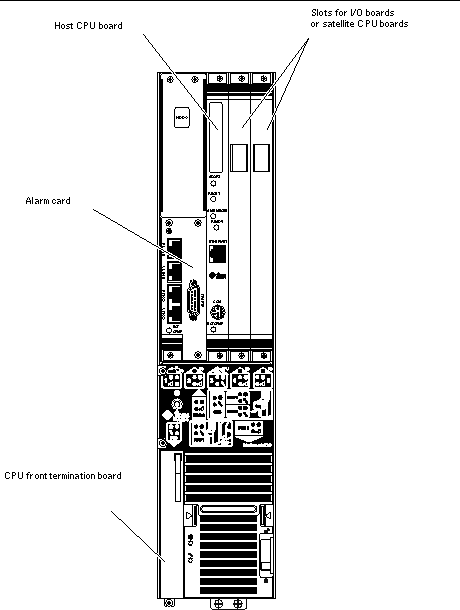
Before removing and replacing any of the main boards in your server, you must first understand all rules and restrictions involved. The following sections provide the rules and restrictions for the main boards:
Following are the rules and restrictions you must understand before hot-swapping any board in the Netra CT server:
1. You must have the host board and alarm card installed in the Netra CT server before you can hot-swap any I/O board or satellite CPU board.
2. If a component is in a failed condition; you must perform a basic hot-swap. To determine if a board has failed, verify that the LEDs are in following states:
See Chapter 4 for detailed tables listing the meanings of LED states. If the board has failed, you must manually unconfigure the board by entering the following commands before you can hot-swap it:
where ap_id is the attachment-point ID listed in the first column.
If the LED states continue to show a failed condition for the board, then you must halt the system.
3. You can only remove a board if all of the LEDs are in the following states:
Do not remove any board from the system if any of the LEDs are in a different state from those listed here.
Following are the rules and restrictions you must understand before hot-swapping a host CPU board:
1. You must have the alarm card and system controller board installed in the Netra CT server before you can hot-swap the host CPU board.
2. When you remove a host CPU board from a server while the server is running, the CompactPCI board is disabled, which means that the connection with all I/O boards installed in the server is lost. Once the CompactPCI bus is disabled, MCNet is disabled in the system.
After you install the host CPU board back into the server, CompactPCI bus is enabled and attempts to connect to all occupied board slots.
Satellite CPU boards are unaffected by the disabling of the CompactPCI bus; they continue to function as stand-alone processors when you hot-swap a host CPU board.
3. If a host CPU is at the OpenBoot prompt (the ok prompt) and you want to hot-swap the host CPU board, you must power off the host CPU slot through the alarm card.
To power off the host CPU slot in a Netra CT server, access the alarm card and through the alarm card command line interface enter:
Refer to the Netra CT Server System Administration Manual for more information about accessing the alarm card.
Use the poweron command to power on the host CPU board after you install the replacement host CPU board.
4. If you are installing a Netra CP2140 host CPU board into a Netra CT server, ensure that the switch settings on the SW0501 switches are set for the default, non-high-availability settings. The Netra CT server supports high-availability hot-swap; however, because the alarm card controls the high availability on the Netra CT server, the settings on the SW0501 switches on the Netra CP2140 host CPU board must be set in the default, non-high-availability settings.
Following are the correct settings for the SMC module switch SW0501 for the Netra CT server (see FIGURE 6-3 and FIGURE 6-4):


5. If you want to reconfigure a Netra CP2500 board from another server or slot where the board was used as a CompactPCI switched backplane (cPSB) board, change the SW3301 dip switch settings to reconfigure the board as a cPCI satellite board. See FIGURE 6-5 for an illustration of the correct settings for use as a cPCI board.

Following are the rules and restrictions you must understand before hot-swapping an alarm card:
1. You must have the host CPU board and the system controller board installed in the Netra CT server before you can hot-swap an alarm card.
2. You cannot hot-swap any other component in a Netra CT server unless the alarm card is installed and fully booted.
The individual slots in your server are set to full hot-swap by default. You can change the slots to basic hot-swap manually. See Chapter 5 for more information.
|
Note - Do not proceed with the following instructions until you review the information in Section 6.1.1, Rules and Restrictions for Hot-Swapping Boards. Failure to do so might result in an inadvertent system reboot or incorrect configuration. |
1. Locate the board that you want to remove from the server.
FIGURE 6-1 shows the locations of the boards in a Netra CT 810 server. FIGURE 6-2 shows the locations of the boards in a Netra CT 410 server.
2. Log in to the Netra CT server.
See Section 5.2.1, Logging In to the Netra CT Server, then go to the next step.
3. Perform any board-specific software commands.
4. Determine the hot-swap state for the slot that holds the board you want to remove.
To determine the current hot-swap state for the slots in your server, as superuser, enter:
The output is similar to the following (note that the following output is for a Netra CT 810 server; the output is similar for the Netra CT 410 server):
5. Identify the attachment-point ID that corresponds to the slot that contains the board you want to remove.
For a Netra CT 810 server, output similar to the following is displayed:
For a Netra CT 410 server, output similar to the following is displayed:
The attachment-point ID is shown in the first column of the readout; for example, the attachment-point ID for slot 4 in a Netra CT 810 server is IO-4.
6. Disconnect the board with the cfgadm (1M) utility:
where ap_id is the attachment-point ID. For example, to deactivate the board in slot 4, as superuser, enter:
7. If you are hot-swapping an alarm card, reset the alarm card before removing it.
Refer to the Netra CT Server System Administration Manual for more information.
8. Attach the antistatic wrist strap.
See Section 1.2, Attaching the Antistatic Wrist Strap.
9. Using a No. 2 Phillips screwdriver, loosen the two captive screws inside the board's ejection levers, one on top and one on the bottom (FIGURE 6-6).
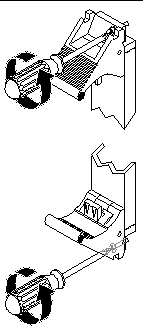
10. Unlock the ejection levers.

|
Caution - Only unlock the ejection levers at this point; do notunseat the board until the LEDs on the system status panel are in the proper state. |
The method you use to unlock the ejection levers varies depending on the model of the ejection lever used on the board; for example, one model uses red tabs at the top and bottom to unlock the board (FIGURE 6-7). Refer to the documentation that came with the board for instructions on unlocking the board.

11. Locate the LEDs on the system status panel for the board that you want to remove.
The system status panel on each server has LEDs that show the status of the board installed in each set of the slots in that server. FIGURE 6-8 shows the LEDs on the Netra CT 810 server and FIGURE 6-9 shows the LEDs on the Netra CT 410 server.

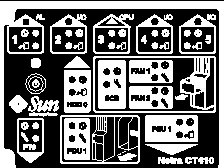
12. Determine if you can remove the board safely at this time.
You can remove the board only if all of the LEDs are in the following states:
It might take several seconds or minutes for the LEDs to transition to the proper states.
For detailed information on states of the system status panel LEDs, see Section 4.1, Troubleshooting the System Using the System Status Panel. Do notremove a board unless all of the LEDs are in the proper states. If you remove a board when any of the LEDs are not in the proper state, the action might cause unpredictable results.
|
Note - If the server is set to the default full hot-swap mode, unlocking the ejection levers automatically starts the cfgadm unconfigure operation. If you decide that you do not want to remove the board, you must wait until the LEDs are in the correct state (as shown in Step 12), completely unseat the board, reseat it, then lock the ejection levers again to start the cfgadm configure operation. Simply locking the ejection levers after unlocking them does not start the driver attachment process. |
13. When it is safe to remove the board, disconnect any cables connected to the board.
14. Press outward on the two ejection levers on the board to unseat the board from the board cage.
15. Carefully slide the board out of the slot and place it on an electrostatic discharge mat.
If you enter the cfgadm command after you remove the alarm card, you see disconnected under the Receptacle column. For all other boards, after you remove the board, you see empty under the Receptacle column.
16. Perform any necessary board-specific hardware procedures.
For example, you might want to remove the PCI mezzanine card (PMC) from a faulty satellite CPU or I/O board, and install it on the replacement board. Refer to the documentation that you received with your board for more information.
17. If necessary, secure a blank filler panel over any empty I/O slots.
If you are not going to replace the board right away, you must install a blank filler panel over the opening to ensure proper airflow in the system. The slot filler panel is secured to the board cage using two screws, one at the top of the filler panel, the other at the bottom.
18. Remove the rear transition module.
For instructions, see Section 6.2, Rear Transition Modules.
1. Attach the antistatic wrist strap.
See Section 1.2, Attaching the Antistatic Wrist Strap.
2. Locate the board slot where you are installing the board.
FIGURE 6-1 shows the locations of these boards in the Netra CT 810 server. FIGURE 6-2 shows the locations of these boards in the Netra CT 410 server.

|
Caution - If you are installing a Netra CP2500 boad in a Netra CT 810 server, do not install the board in slots 6 and 7. |
3. Install the rear transition module first, using the instructions in Section 6.2, Rear Transition Modules.
After you've completed the rear transition module removal and installation instructions, continue with the next step.
4. Remove the slot filler panel, if necessary.
The slot filler panel is secured to the board cage using two screws, one at the top of the filler panel, the other at the bottom. Store the slot filler panel in a safe place; you might use it again if you need to remove a board for an extended period of time.
5. Obtain the replacement board from the shipping kit.
6. If you are installing a new alarm card, remove the blue protective film from the front of the alarm card.
7. Perform any necessary board-specific hardware procedures.
a. If you removed a PMC from a satellite CPU or I/O board, install the PMC into the replacement satellite CPU or I/O board at this time.
Refer to the documentation that you received with your satellite CPU or I/O board for more information.
b. If you want to reconfigure a Netra CP2500 board from another server or slot where the board was used as a cPSB, change the SW3301 dip switch settings to reconfigure the board as a cPCI satellite board.
FIGURE 6-5 shows the dip switch settings required for the Netra CP2500 board to be used as a cPCI board.
8. Verify that the ejection levers on the board are unlocked.
You cannot install the board properly if the ejection levers are locked.
9. Keeping the board vertical, slide the board into the slot between the two guides.
The cuts in the handle of the board must align with the square cutouts in the slot. When the board is completely seated in the board cage, the two ejection levers flip inward, and the notches in the ejection levers fit smoothly in the rectangular cutouts in the bottom and top plates.

The method you use to lock the ejection levers varies depending on the model of the ejection lever used on the board. Refer to the documentation that came with the board for instructions on locking the ejection levers.
11. Using a No. 2 Phillips screwdriver, tighten the two captive screws inside the board's ejection levers, one on top and one on the bottom.
Tighten the screws to a torque of 0.28 N.m (2.5 in.-lb).
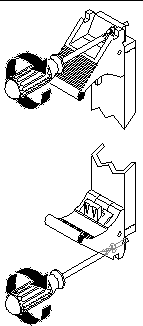
12. Log into the Netra CT server.
See Section 5.2.1, Logging In to the Netra CT Server.
13. Determine the hot-swap state for the slot that holds the board you just installed.
To determine the current hot-swap state for the slots in your server, as superuser, enter:
14. Identify the attachment-point ID that corresponds to the slot where you inserted the board.
15. Connect the board with the cfgadm dynamic reconfiguration software:
where ap_id is the attachment-point ID. For example, to connect the board in slot 4, as superuser, enter:
16. Activate the board with the cfgadm (1m) utility:
where ap_id is the attachment-point ID. For example, to activate the board in slot 4, as superuser, enter:
17. Locate the LEDs on the system status panel for the board that you just inserted.
FIGURE 6-8 shows the LEDs on the Netra CT 810 server and FIGURE 6-9 shows the LEDs on the Netra CT 410 server.
18. Determine if the board is activated.
For detailed information on states of the system status panel LEDs, see Section 4.1, Troubleshooting the System Using the System Status Panel.
19. If the board activates successfully, perform any necessary board-specific software configuration.
20. Connect the cables to the board.
Tighten the screws on the cable to a torque of 0.23 N.m (2 in.-lb).
The following figures show the connectors for the boards available for the Netra CT servers:
For the connectors on the satellite CPU and I/O boards, refer to the documentation that you received with those boards.
See Appendix A for connector pinouts for each board, if necessary.
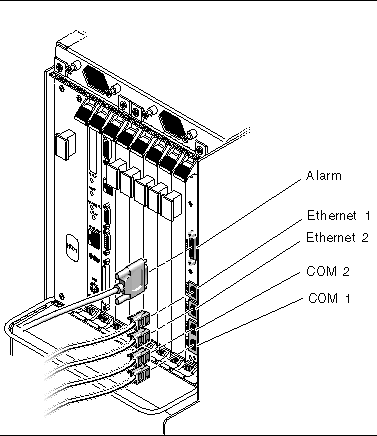
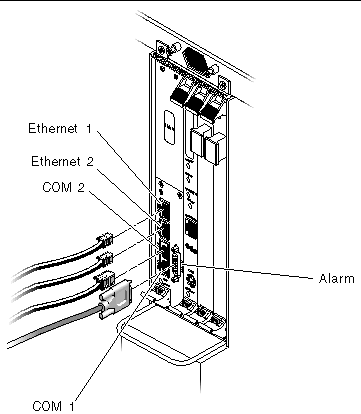

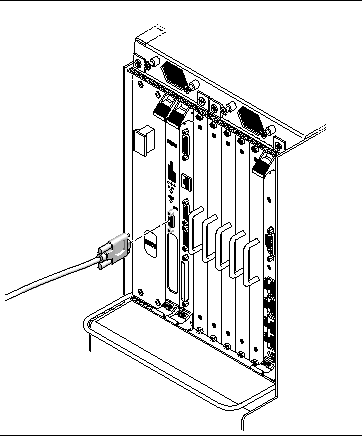
|
Note - The rear-transition modules are only hot-swappable as long as the accompanying host or satellite board is removed first. |
The following rear transition modules extend the ports from the host and satellite boards to the rear:
This section contains procedures for the installation, removal, and replacement of the following hot-swappable modules for the Netra CT 410 server and Netra CT 810 server:
This section explains how to remove and replace host rear transition modules.
The following are the possible pairings of host boards with rear transition modules:
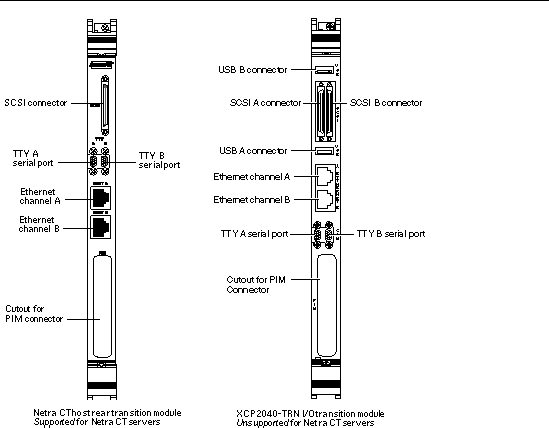

1. Attach the antistatic wrist strap.
See Section 1.2, Attaching the Antistatic Wrist Strap.
2. Go to the front of the system and remove the host CPU board, if you have not done so already.
See Section 6.1.2.1, Removing a Board to remove the host CPU board.
3. Go to the rear of the system and locate the host rear transition module.
FIGURE 6-18 shows the location of the host rear transition module on the Netra CT 810 server, and FIGURE 6-19 shows the location of the host CPU rear transition module on the Netra CT 410 server.

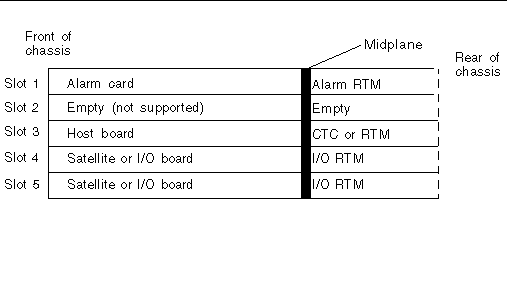
4. Unplug any cables attached to the host rear transition module.
5. Using a No. 2 Phillips screwdriver, loosen the two captive screws inside the module's ejection levers, one on top and one on the bottom (FIGURE 6-6).
6. Press out on the ejection levers to unseat the module.
7. Slide the module out of the slot, and place it on an electrostatic discharge mat.
1. Attach the antistatic wrist strap.
See Section 1.2, Attaching the Antistatic Wrist Strap.
2. Get the replacement host rear transition module from the shipping kit.
3. Keeping the host rear transition module vertical, slide the module into the slot in between the two guides (FIGURE 6-20).
The teeth in the handle of the module must align with the square cutouts in the slot. When the module is completely seated in the cage, the two ejection levers flip inward, and the teeth in the ejection levers fit smoothly in the rectangular cutouts in the bottom and top plates. FIGURE 6-20 shows how to insert an I/O board into a slot; the same method applies to a host rear transition module.
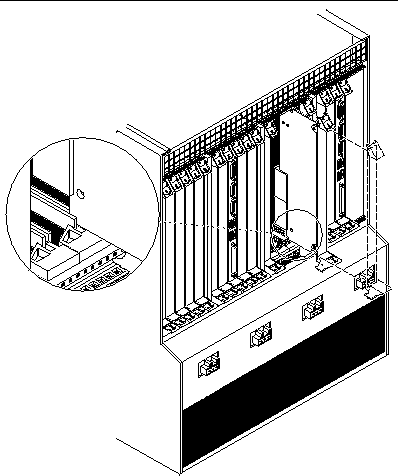
4. Using a No. 2 Phillips screwdriver, tighten the two captive screws inside the module's ejection levers, one on top and one on the bottom (FIGURE 6-11).
Tighten the screws to a torque of 0.28 N.m (2.5 in.-lb).
5. Make the necessary cable connections to the host rear transition module.
Tighten the screws on the cable to a torque of 0.23 N.m (2 in.-lb).
FIGURE 6-16 and FIGURE 6-17 show the connectors on host rear transition modules.
6. After you replace the host CPU rear transition module, get the replacement host CPU board from the shipping kit.
7. Go to the front of the server and install the replacement host CPU board.
See Section 6.1.2.2, Inserting a Board for instructions.
This section describes the pairings of satellite boards and rear transition modules, and it explains how to remove and replace satellite rear transition modules (RTMs).
A satellite rear transition module set consists of two separate boards:
The satellite board is installed from the front of the Netra CT server; however, no cables are connected to the satellite CPU board.
The following are possible satellite board and rear transition module combinations:
The rear transition module extends the ports from the PMCs installed in the satellite CPU board to the PMC I/O module (PIM) installed in the satellite CPU rear transition module. The satellite CPU board must be installed in the same slot at the front of the server for the satellite CPU rear transition module to work. For example, if you install a satellite CPU rear transition module in I/O slot 3 at the rear of a Netra CT 810 server, you must install the accompanying satellite CPU board in I/O slot 3 at the front of the server.
When one of the two components fails, you might not be able to determine which of the components failed. Because of this, you might want to replace both the satellite CPU board and the satellite CPU rear transition module. FIGURE 6-21 and FIGURE 6-22 show graphical representations of how the satellite CPU boards align with the satellite CPU rear transition modules. If you are facing the front of the server, the I/O slots read from left to right, whereas they read from right to left if you are facing the rear of the server.


The I/O rear transition module set consists of two separate boards:
The I/O board contains the application-specific integrated circuit (ASIC) for the associated I/O board and is installed from the front of the server; however, no cables are connected to the I/O board.
The I/O rear transition module extends the ports for a particular I/O board to the rear of the server. The I/O rear transition module and the I/O board must be installed in the same slot at the front of the server for the I/O rear transition module to work. For example, if you install an I/O rear transition module in I/O slot 3 at the rear of a Netra CT 810 server, you must install the accompanying I/O board in I/O slot 3 at the front of the server.
When one of the two components fails, you might not be able to determine which of the components failed. Because of this, you might want to replace both the I/O board and the I/O rear transition module. FIGURE 6-21 and FIGURE 6-22 show graphical representations of how the I/O boards align with the I/O rear transition modules. Note that, if you are facing the front of the server, the I/O slots read from left to right, whereas they read from right to left if you are facing the rear of the server.
1. Attach the antistatic wrist strap.
See Section 1.2, Attaching the Antistatic Wrist Strap.
2. Locate the board slot that holds the satellite CPU or I/O board.
3. Remove the satellite CPU or I/O board from the front of the Netra CT server.
See Section 6.1.2.1, Removing a Board.
4. After you remove the satellite CPU or I/O board from the front of the Netra CT server, go to the rear of the server and locate the rear transition module.
FIGURE 6-21 shows the slots available for the rear transition modules in a Netra CT 810 server, and FIGURE 6-22 shows the slots available for the rear transition modules in a Netra CT 410 server.
5. Unplug any cables attached to the rear transition module.
6. Using a No. 2 Phillips screwdriver, loosen the two captive screws inside the rear transition module's ejection levers, one on top and one on the bottom (FIGURE 6-6).
7. Unlock the ejection levers.
8. Press outward on the two ejection levers on the module to unseat the board from the board cage.
9. Carefully slide the rear transition module out of the slot, and place it on an electrostatic discharge mat.
10. Perform any necessary board-specific hardware procedures.
For example, you might want to remove a PIM from a faulty satellite CPU or I/O board, and install it on the replacement board. Refer to the documentation that you received with your board for more information.
11. If necessary, secure blank filler panels over the empty I/O slots.
If you are not going to replace the boards right away, you must install blank filler panels over the openings to ensure proper airflow in the system. The slot filler panels are secured to the board cage using two screws, one at the top of the filler panel, the other at the bottom.
1. Attach the antistatic wrist strap.
See Section 1.2, Attaching the Antistatic Wrist Strap.
2. Remove the slot filler panel, if necessary.
FIGURE 6-21 shows the slots available for the rear transition modules in a Netra CT 810 server, and FIGURE 6-22 shows the slots available for the rear transition modules in a Netra CT 410 server.
The slot filler panel is secured to the board cage using two screws, one at the top of the filler panel, the other at the bottom.
3. Get the replacement rear transition module from the shipping kit.
4. Perform any necessary board-specific hardware procedures.
a. If you removed a PIM from a satellite CPU or I/O board, install the PIM into the replacement satellite CPU or I/O board.
Refer to the documentation that you received with your satellite CPU or I/O board for more information.
b. If you want to reconfigure a Netra CP2500 RTM-S from another server or slot where the board was used as a cPSB satellite transition module, change the SW3301 dip switch settings to reconfigure the board as a cPCI board.
FIGURE 6-5 shows the dip switch settings required for the Netra CP2500 RTM-S to be used as a cPCI board.
5. Verify that the ejection levers are unlocked.
You cannot install the board properly if the ejection levers are locked.
6. Keeping the board vertical, slide the rear transition module in between the two guides into the slot (FIGURE 6-20).
The teeth in the handle of the board must align with the square cutouts in the I/O slot. When the board is completely seated in the board cage, the two ejection levers flip inward, and the teeth in the ejection levers fit smoothly in the rectangular cutouts in the bottom and top plates.
The method you use to lock the ejection levers varies depending on the model of the ejection lever used on the board. Refer to the documentation that came with the I/O board for instructions on locking the ejection levers.
8. Using a No. 2 Phillips screwdriver, tighten the two captive screws inside the board's ejection levers, one on top and one on the bottom.
Tighten the screws to a torque of 0.28 N.m (2.5 in.-lb).
9. Plug all appropriate cables into the rear transition module.
Tighten the screws on the cable to a torque of 0.23 N.m (2 in.-lb). Refer to the documentation that you received with the board.
10. Go to the front of the server, and install the satellite CPU or I/O board in the Netra CT server.
See Section 6.1.2.2, Inserting a Board for instructions.
The alarm rear transition module for the Netra CT 810 server consists of two separate components:
When one of the two components fails, you might not be able to determine which of the components failed. Because of this, you might want to replace both the alarm card and the alarm rear transition module.
The alarm card is installed in the front of the Netra CT server.
The alarm rear transition module extends the ports on the alarm card to the rear of the system. The alarm card must be installed in the front of the server for the alarm rear transition module to work.
1. Attach the antistatic wrist strap.
See Section 1.2, Attaching the Antistatic Wrist Strap.
2. Remove the alarm card from the front of the Netra CT server.
See Section 6.1.2.1, Removing a Board for instructions.
3. After you remove the alarm card from the front of the Netra CT server, go to the rear of the server and locate the alarm rear transition module.
FIGURE 6-23 shows the slot available for the alarm rear transition module in a Netra CT 810 server, and FIGURE 6-24 shows the slot available for the alarm rear transition module in a Netra CT 410 server.
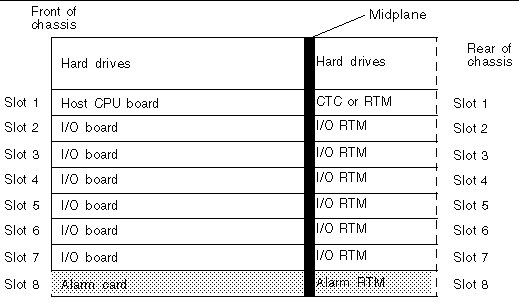
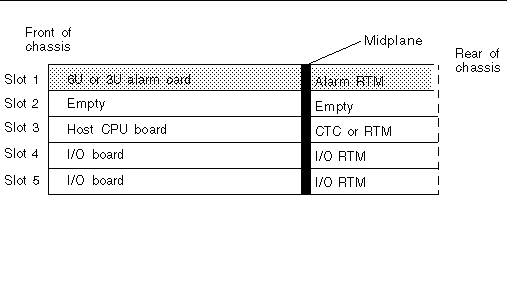
4. Unplug any cables attached to the alarm rear transition module.
5. Using a No. 2 Phillips screwdriver, loosen the two captive screws inside the card's ejection levers, one on top and one on the bottom.
6. Unlock the ejection levers on the card.
7. Press outward on the two ejection levers on the card to unseat the card from the card cage.
8. Slide the card out of the slot and place it on the electrostatic discharge mat.
9. If necessary, secure blank filler panels over the empty I/O slot.
If you are not going to replace the alarm card and alarm rear transition module right away, you must install blank filler panels over the openings to ensure proper airflow in the system. The slot filler panels are secured to the card cage using two screws, one at the top of the filler panel, the other at the bottom.
1. Attach the antistatic wrist strap.
See Section 1.2, Attaching the Antistatic Wrist Strap.
2. Remove the slot filler panel, if necessary.
FIGURE 6-23 shows the slot available for the alarm rear transition module in a Netra CT 810 server, and FIGURE 6-24 shows the slot available for the alarm rear transition module in a Netra CT 410 server.
The slot filler panel is secured to the board cage using two screws, one at the top of the filler panel, the other at the bottom.
3. Get the replacement alarm rear transition module from the shipping kit.
4. Remove the blue protective film from the front of the alarm rear transition module.
5. Verify that the ejection levers are unlocked.
You cannot install the module properly if the ejection levers are locked.
6. Keeping the module vertical, slide the module into the slot between the two guides (FIGURE 6-20).
The teeth in the handle of the module must align with the square cutouts in the I/O slot. When the module is completely seated in the board cage, the two ejection levers flip inward, and the teeth in the ejection levers fit smoothly in the rectangular cutouts in the bottom and top plates. FIGURE 6-10 shows how to insert an I/O board into a slot; the same method applies to an alarm rear transition module.
7. Using a No. 2 Phillips screwdriver, tighten the two captive screws inside the module's ejection levers, one on top and one on the bottom.
Tighten the screws to a torque of 0.28 N.m (2.5 in.-lb).
8. Lock the ejection levers on the module.
9. Plug all appropriate cables into the alarm rear transition module.
Tighten the screws on the cable to a torque of 0.23 N.m (2 in.-lb).

10. Get the replacement alarm card from the shipping kit.
11. Verify that the ejection levers are unlocked.
You cannot install the alarm card properly if the ejection levers are locked.
12. Go to the front of the server, then install the replacement alarm card in the Netra CT server.
See Inserting a Board for instructions.
Copyright © 2007, Sun Microsystems, Inc. All Rights Reserved.